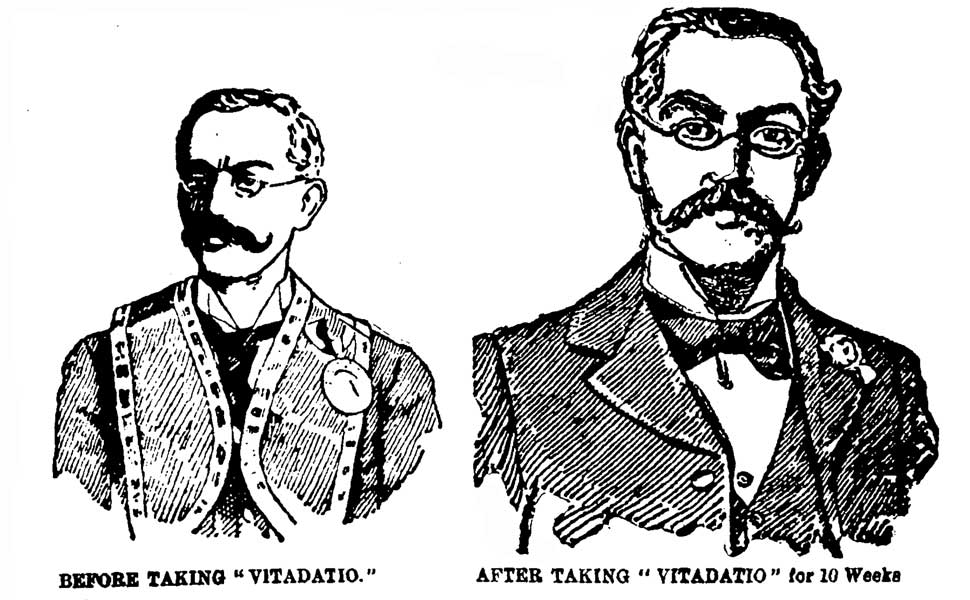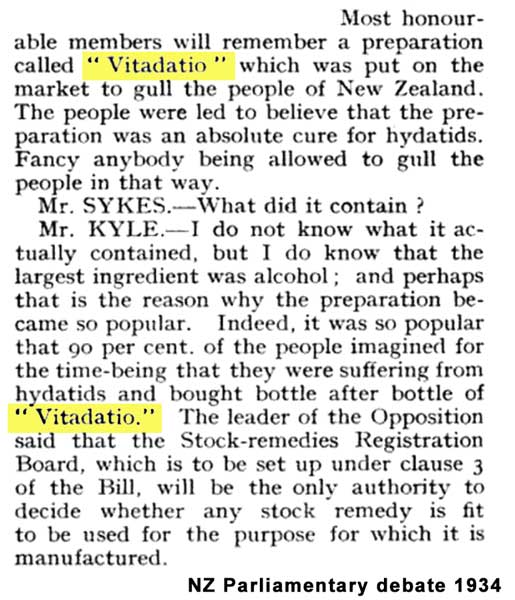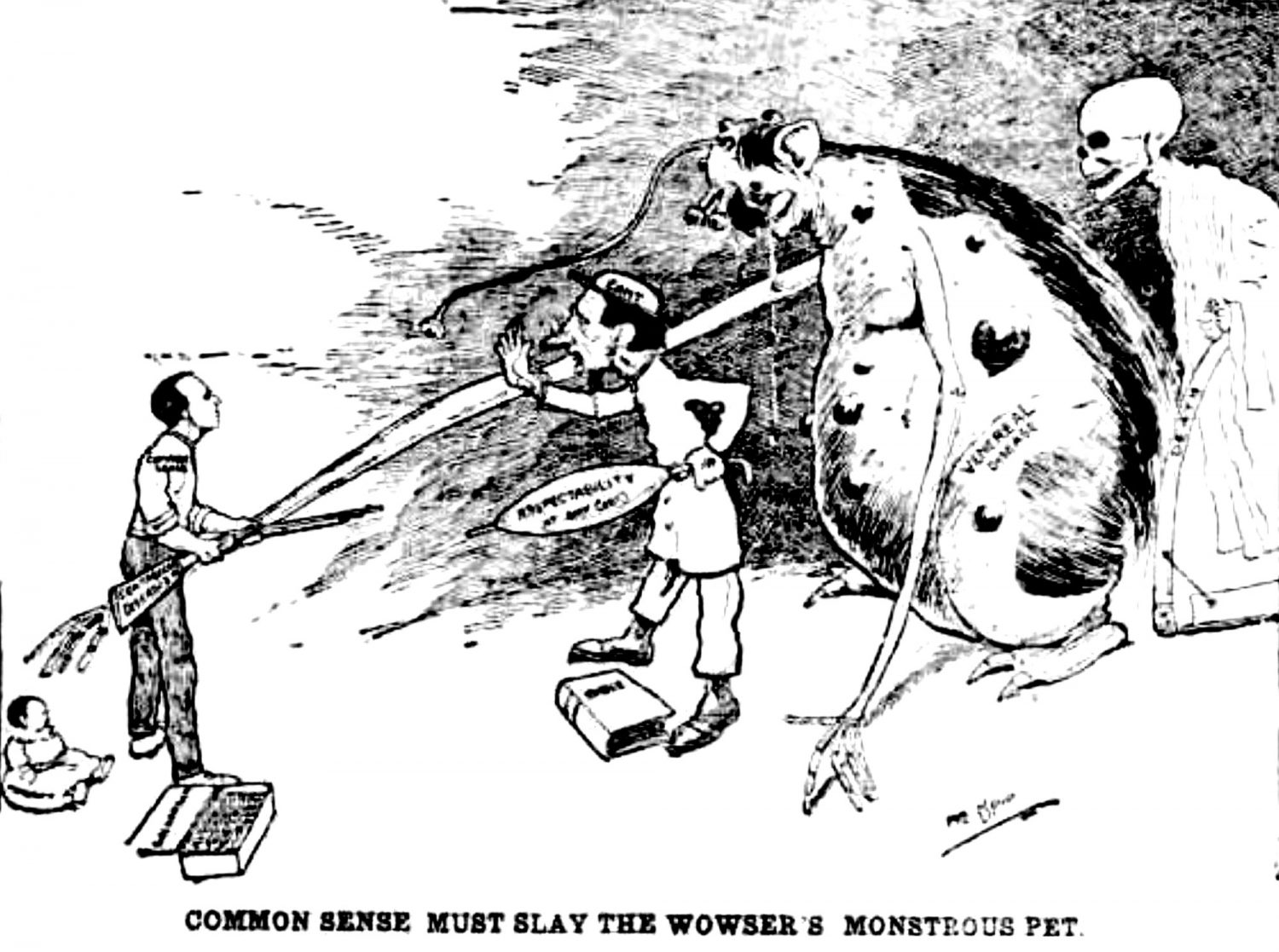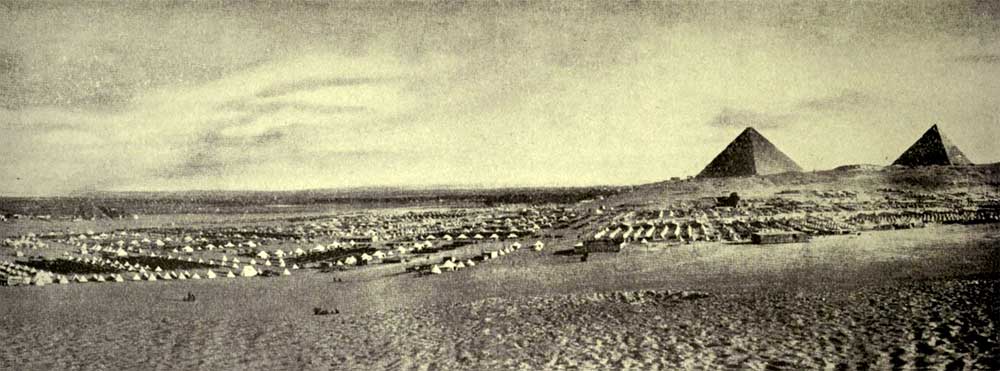Not aglow? Try Vitadatio!!
VITADATIO
HOW IT WAS DISCOVERED
……A certain gentleman in Launceston, Tasmania, found himself one day under an obligation to a gentleman of that town, and offered to place him in possession of a secret which he long held. This secret, he declared, had enabled him for many years to cure his friends and acquaintances of long-standing diseases, and had kept him also in the best of health up to what was a ripe old age. Eventually the secret of a peculiar blend of certain herbs was revealed, and the medicine put to a severe practical test, which test, it may be stated, resulted in the most extraordinary success. From being the secret fad of this amiable old enthusiast Vitadatio gradually spread to becoming the popular remedy of a large number of people in Tasmania, until, at length, the demand becoming so great, business negotiations had to be entered upon for an enormous supply to satisfy the wants of its ever increasing number of friends. From Tasmania it spread to New Zealand, where it quickly became in such demand that a central depot for its distribution had to be established.
Its history in Australia is almost too new to need recapitulation here. From a modest start about three years ago it quickly caught the public taste, disease after disease was conquered by its peculiar properties, and it was evident from but six months workings that Vitadatio had come to stay. The public are doubtless well accustomed to hearing of cures being performed by some patent medicine after the medical faculty has despaired of success. But these cures appear chiefly in the advertisement columns of the daily newspapers, and it will but seldom bear the investigation which a little publicity and enquiry makes. Vitadatio, however, has this advantage in its financial and commercial arrangements, that almost everyone connected with it, from its energetic Australasian Distributor at its head, down through all the departments to the lowest office, all are able to testify what this wonderful medicine has done for them. Mr. Palmer who is the Sole Distributor for Australasia, will show incontestable proof that he has been cured by Vitadatio, and by nothing else from that scourge, known as Hydatids, and this after his case had been given up by all the medical men, whom he consulted, and after undergoing a painful operation which was quite ineffectual. But after a course of this medicine not only was he completely cured but he was accepted by a leading Life Insurance Company as a first class life at their ordinary rates.
 A similar story can be told by others employed by Mr. Palmer at his branch establishments for the distribution of this medicine, so that it is quite easy for the public to satisfy themselves that all the cures claimed can be substantiated. One peculiarity of Vitadatio is to be found in the fact that the various herbs of which it is composed grow in Tasmania only, as far as is yet known and are indeed peculiar to that healthy little island. It is perhaps in this fact that the reason may be found why Vitadatio has not been discovered before in this very old planet of ours, where, it is stated, there is nothing new under the sun. Tasmania is about as old as Sydney, that is about 100 years, since our settlers occupied it, so that it is not surprising that this remedy has only within the past few years been discovered. An advantage to our colonial population in purchasing this medicine lies in the fact that the manufacture and distribution of Vitadatio employs many hundreds of people in all parts of the colonies, and that the money spent by the public does not have to be sent to other places, but stays here. This, of course, is but a minor point in comparison with the far more important fact that no, matter what your disease may be Vitadatio has proved itself to be worth a trial. This is the main fact which justifies the confidence all people feel who have once given it a trial and far outweighs any other argument which may be used in its behalf. For further particulars, S. A. PALMER, 184 Pitt street, Sydney. Correspondence Invited. Write for Testimonials.
A similar story can be told by others employed by Mr. Palmer at his branch establishments for the distribution of this medicine, so that it is quite easy for the public to satisfy themselves that all the cures claimed can be substantiated. One peculiarity of Vitadatio is to be found in the fact that the various herbs of which it is composed grow in Tasmania only, as far as is yet known and are indeed peculiar to that healthy little island. It is perhaps in this fact that the reason may be found why Vitadatio has not been discovered before in this very old planet of ours, where, it is stated, there is nothing new under the sun. Tasmania is about as old as Sydney, that is about 100 years, since our settlers occupied it, so that it is not surprising that this remedy has only within the past few years been discovered. An advantage to our colonial population in purchasing this medicine lies in the fact that the manufacture and distribution of Vitadatio employs many hundreds of people in all parts of the colonies, and that the money spent by the public does not have to be sent to other places, but stays here. This, of course, is but a minor point in comparison with the far more important fact that no, matter what your disease may be Vitadatio has proved itself to be worth a trial. This is the main fact which justifies the confidence all people feel who have once given it a trial and far outweighs any other argument which may be used in its behalf. For further particulars, S. A. PALMER, 184 Pitt street, Sydney. Correspondence Invited. Write for Testimonials.
National Advocate (Bathurst, NSW : 1889 – 1954), Wednesday 6 March 1901, page 3
“VITADATIO”
PROSECUTION IN SYDNEY, FALSE DESCRIPTION ALLEGED
SYDNEY, Friday. Elliott Bros Ltd wholesale merchants, were proceeded against in the summons division of the Water Police Court today before Mr. Barnett, S. M. in regard to a medicine known as “Vitadatio,” which the information set out was falsely described, in contravention of the Pure Foods Act. Mr Robison appeared to prosecute on behalf of the Crown. Mr Windeyer appeared for the defendants.
In outlining the case for the prosecution Mr. Robison said that the Crown relied on a statement printed in a pamphlet sold with the medicine. The pamphlet set out that “Vitadatio” was a great herbal remedy for Bright’s disease, had cured Bright’s disease, hydatids, stricture, cancer, consumption, and ringworm, and would cure the most severe case of hydatids, tumorous growth, lung trouble, and heart trouble.
A certificate by Dr. Cooksey, Government analyst, was put in, stating that “Vitadatio” contained:
alcohol (by weight 1.1 per cent., equal to proof spirit 2.5 per cent ) salicylic acid (half a grain to the pint), tannin, and vegetable extractions, consisting of extract of gentian, sarsaparilla, and a small quantity of senna or rhubarb.
Dr. J. B. Cleland, principal Government microbiologist, said that the medicine in question was certainly not a cure for cancer, hydatids or ringworm and the alcohol in the preparation would be harmful to Bright’s disease. Neither would it cure consumption or tumorous growths. After further medical expert evidence had been given, Mr. Barnett asked Dr. A. A. Palmer, first Government medical officer, if the concoction known as “Vitadatio” would have any effect upon any disease with the exception of Bright’s disease
Dr. Palmer: No.
Mr Barnett: What would be the effect upon any person suffering from Bright’s disease?
Dr Palmer: It would not have any beneficial effect. It might even have a deleterious effect.
For the defence Sydney Arthur Palmer of Flinders lane, Melbourne, said he was proprietor of “Vitadatio,” and had been so since February 1914. Previous to that he had been agent for the mixture. He purchased “Vitadatio” from W. Webber of Tasmania. As far as witness knew the claims that the mixture had cured the diseases set out were true. He had known the recipe for 19 years, and the analysis put forward by the Government was not correct. Outside the spirit and salicylic acid, which were used as preservatives, there were only two ingredients. One was a herb which witness knew, and the other was one about which he did not know much, but which he purchased in Tasmania.
Defendants were fined £10, with 6/ [shillings] costs.
Argus (Melbourne, Vic. : 1848 – 1957), Saturday 29 May 1915
In 1934 the cure-all got an unfavourable mention in a New Zealand parliamentary debate.
The recipe for Vitadatio is recorded in John Rowland Skemp’s book ‘Memories of Myrtle Bank’:
- 1 bucket of water,
- 1 handful tea-tree and (native) hops,
- 1⁄4 pound sassafras bark,
- 3 or 4 pieces of brooklime,
- 2 pieces of hore-hound,
- 3 dock roots,
- 12 English dandelion roots,
- 1⁄2 stick liquorice,
- 2 tablespoons ginger,
- 1⁄4 pound treacle,
- 6d. gin.
Boil 3 hours – not fast – then strain, bottle and cork tight. Take a wineglass after every meal.


















Such interesting information. Mr Sydney Arthur Palmer was my great grandfather. One of his daughters was my grandmother. Unfortunately I do not have a lot of information about the Palmers. I think that my grandmother and her siblings were from his ‘second’ family in Australia. I don’t think he actually divorced his family in England first! My grandmother had a stroke early in my childhood and her speech was effected and I was unable to understand any information she may have had about her father. The photo Zanette mentions would be fabulous to see. If I can help in any way please let me know. By the way, my father was not at all please that Vitadatio has been described by some as “snake oil”!.
I am the Great-grandaughter of Edward Barnard who supplied the tea-tree for the production of Vitadatio. He lived at Underwood, Tasmania, and was a supplier for many years.
I was interested to read more detail about the product in the article above.
I have a photograph of my great-grandfather with Mr Palmer (and others). My Mother told me that Mr Palmer came from Leeds (England) & some years ago I had contact from a member of his family over there.
Nice to read your comments Zanette. If you can provide a photo I will include it and any relevant details in the story above. Cheers
PJG … thanks for the forum. Lots of information here!
Hi Graham, I am descended from William Webber’s wife’s family. I don’t have the relevant information at hand just now but, off hand, I’m 95% sure she was named Mary Jane Walmsley, sister to my Great-grand-father George Walmsley.
George may have been involved in his brother-in-law’s production of Vitadatio … I surmise this because, although a farmer with modest acreage, he managed to send my grandfather to Northern Tasmania’s most prestigious boys’ school with the aim of him becoming a chemist & owned properties in Launceston.
My Grandfather, Robert Hamilton Ellis Walmsley, was 1st cousin to William Hamilton Webber ( ‘Hamilton’ being a popular name in the Walmsley family).
The point is, I know William Webber Jr (who professionally went by ‘Hamilton Webber’) had two sons (off hand I recall that ‘Patrick/Paddy’ was one) & I hope you may know what became of them so I can ‘flesh out’ my extended family tree. Cheers,
Noel Hamilton Hall.
Good to see this, but no mention of its inventor William Webber. I am descended from one of his brothers in the parish of Kea in Cornwall. To date we have been unable to find when William Webber arrived in Tasmania and then settled in Launceston? Vitadatio also made it to England. William arrived back in England for a visit on the eve of World War I, with his wife and son, William Hamilton Webber the musical arranger. William died here and is buried in Putney Vale Cemetery. I have a photo of him sitting with my great grandfather Nicholas Webber.
Thanks for your comments Graham. There are quite a few references to William Webber living in Invermay (a suburb of Launceston Tasmania in the local newspaper archives including the following re his will. I too have not yet discovered when he arrived in Tasmania.
Mercury (Hobart, Tas. : 1860 – 1954), Friday 25 July 1924, page 11
LAUNCESTON PRACTICE COURT. WILLIAM WEBBER’S WILL.
40 ENGLISH CLAIMANTS. LAUNCESTON, July 24.
In the Practice Court today before Mr Justice Crisp, Mr G Waterhouse asked for directions as to service in connection with the will of the late William Webber of Launceston The question which would later come before the court he said related to a decision as to whether certain mortgages for £1,700, under the circumstances set out, were still enforceable, or were barred by the statute of limitations If the decision in regard to this matter should be in the negative, there would be no necessity to enter into any other question The persons interested in the mortgages were the beneficiaries of the will, Emma Parker, who owned certain land subject to the mortgage referred to, and people in England Mr Webber had made his will in 1880, and had directed that his estate, as set out, should go to his cousins, then resident in Sussex, England. The will was made 44 years ago, and in response to advertisements inserted in English newspapers, over forty persons had to date sent in claims, purporting to be the cousins to whom William Webber had left his estate. He asked the court to direct that a summons should be served on John Howe Millar, as trustee for the will of the late Emma Parker, and that the Tasmanian Permanent Executors and Trustees Association might be served to represent the parties in England entitled to the mortgage moneys. The order asked for was granted, costs to be costs in the matter.
Hi Graham, William Webber left Cornwall for the United States. In 1876 he married Harriet Margaret Moser, a local lass from Schuylkill, Pennsylvania. In early 1877 Harriet gave birth to their first daughter, Clara. The family departed New York on 2 June 1877 aboard the ‘Star of the West’ bound for Sydney. The ship arrived on 11 September 1877. In the shipping records, the 27-year-old William identified his ‘calling’ as blacksmith and his religion as Methodist. He also declared that his brother, John Webber, was resident in Sydney (New South Wales Assisted Immigrant Passenger Lists, 1828-1896). The family appears not to have stayed in Sydney for very long. Although I have not been able to find any official shipping records to record when William and his family arrived in Tasmania, we know that William and Harriet’s second daughter, Harriet Bertha Luz Webber, was born in Hobart on 17 June 1878. By about 1880 William had established himself as a grocer and hop beer manufacturer in Launceston. William is my great-great-grandfather and Harriet Bertha Luz Webber my great-grandmother. I’m in the throes of pulling my family history together and would be happy to share my work if you would like any further information.